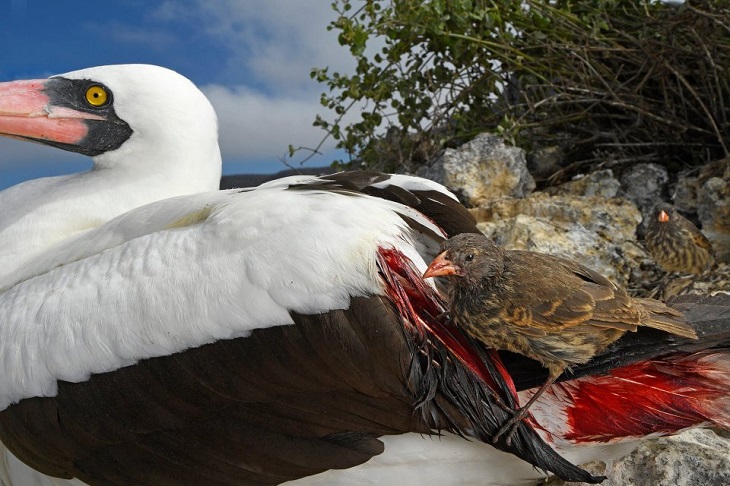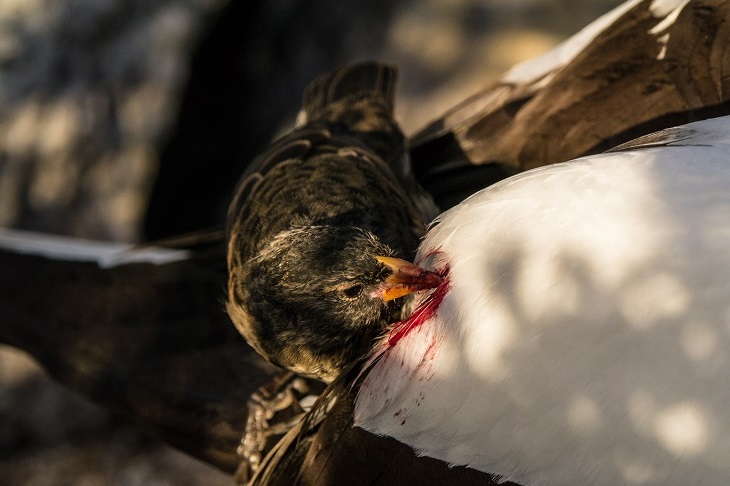
SIGN UP TO RECEIVE
15% OFF
IN YOUR NEXT TOUR

Unraveling the Mystery: The Origins of the Vampire Finch
SCROLL DOWN TO READ

Unraveling the Mystery: The Origins of the Vampire Finch
SCROLL DOWN TO READ
Unraveling the Mystery: The Origins of the Vampire Finch
The Galápagos Islands are renowned for their incredible diversity of endemic species. Among the rarest and most fascinating is the vampire finch (Geospiza difficilis). This unusual bird is a subspecies of the sharp-beaked ground finch, found exclusively on Darwin and Wolf Islands. What sets the vampire finch apart are its striking behavioral differences from other sharp-beaked ground finches.
To delve into the biological adaptations of these finches—particularly their unique behavior of feeding on the “blood” of seabirds during the dry season—the Galápagos National Park (GNP) has initiated a new investigation. This research focuses on understanding the unusual behaviors exhibited by these intriguing finches that inhabit Darwin and Wolf Islands, located at the northern end of the archipelago.

One of the park rangers leading this research explained that the sharp-beaked ground finch, also found on Pinta, Genovesa, Santiago, and Fernandina Islands, typically feeds on seeds and insects. However, these food sources can often be scarce on Darwin and Wolf Islands. Uniquely, these two small and remote islands are the only places where this finch has developed a diet that includes the blood (hematophagy) of other birds.
To gain deeper insights into this unusual feeding behavior, specialists conducted monitoring during the rainy season (January and February). During this time, they collected samples of saliva, blood, and ecological data to better understand the fascinating behavior of the vampire finches.

Through the analysis of these samples, the research team aims to confirm or rule out a fascinating case of “convergent evolution.” This phenomenon, observed in vampires, mosquitoes, and ticks, involves distant species evolving similar molecules (proteins and enzymes) in their saliva to help digest blood anticoagulants and provide anesthetic properties.
Vampire finches use their sharp beaks to peck at the feathers and skin of boobies, sucking their blood as a nutrient-rich supplement to their diet, especially when seeds and insects are scarce. Interestingly, the boobies don’t seem to mind this peculiar feeding behavior. It’s believed that this unique interaction evolved from the finches initially preying on parasites found in the boobies’ feathers.

The vampire finches' unique blood-drinking habits have enabled them to thrive even during the driest months, making them the most numerous birds on the islands. During peak feeding times, you can spot these finches lining up behind a host, patiently waiting their turn to feast.
Sexual dimorphism is evident in this species: males are strikingly black, while females display a softer greyish hue with brown streaks. As an adaptation to their distinctive lifestyle, the vampire finch has evolved the largest and most pointed beak of all the sharp-beaked ground finch subspecies, perfectly suited for their unique feeding habits.
